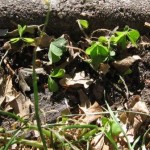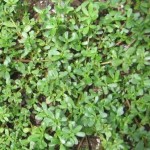Archive for Live Foods
What Grandmother Knew About Colds & Flu
Posted by: | CommentsWe are experiencing one of the most serious widespread flu and cold seasons we have had in a long time. Colds have been holding on for weeks and the flu is totally debilitating. I have had that awful cold; family and friends are suffering with really profound flu symptoms. So I’ve been having many ask me what I do for each. Remembering what my Mother did puts me in touch with my Grandmother as well. Seems like these ways of handling colds and flu might be helpful to others, so here goes.
Colds and flu are different. So the very first thing is to take one of the homeopathic flu remedies since homeopathic remedies have been proven to lessen or stop flu when nothing else does. The remedy that is the most common is Oscillococinum (ah-sill-oh-co-sin-um). Don’t wait until you decide if it is the flu or a cold or it will be too late. Just take it! If it is a cold, the effects will also be lessened by taking a homeopathic medicine.
Remember the old expression “Feed a cold; starve a fever”? This is not really the whole expression as I understand it. It was “If you feed a cold, you’ll have to starve a fever.” So change your eating habits as soon as the first symptoms appear. For a cold, eat lightly of very healthy foods more often. Focus on broths with rice and a few veggies like winter squash and greens; pure juices with no added sugar (or worse yet artificial sweeteners); honey; herbal teas or green tea with ginseng and honey; and half your body weight in ounces of water to help flush out the germs. If there is a mucus build up, eliminate all dairy and wheat as these will increase the mucus secretions. [Yeah, I know it’s hard, just try it anyway. You can do anything for a week, right?]
The other supporters for your healing process are good for both colds and flu. I use zinc lozenges with vitamin C and/or echinacea and elderberry; fresh citrus fruits; traditional healing teas for the symptoms present; homeopathics that also address your symptoms; and a Neti pot with the special sea salt that doesn’t hurt your nose and sinuses. If you don’t use a Neti pot, use a saline spray; I particularly like the one with Xylitol. Rest, rest, rest even if you have to just let everything go, and use a hot or cold vaporizer next to your bed! Other good additions to this regime are garlic capsules 4x/day (600 mg per dose), high B 100 mg sustained release, and emergen-C.
For the flu, you have to be even more aware that you must take care of yourself!!! If the Oscillococinum didn’t nip it in the bud, get the homeopathic from Boiron (the blue tube) called influenzinum. It’s for the effects of flu or flu like symptoms, and it really works! Now is the time to fast. That means get containers of organic broths or have someone make good hardy broth (recipe in next blog), and don’t give your body anything it has to digest until you are good and truly hungry with stomach rumblings! Honey, herb teas, broths, barley water, and water!A liquid fast is a better way to put it. Consume as much as you want, as often as you want to. You won’t be hungry until your body is ready for actual food. Then have a really ripe banana, add rice and greens to the soup, have a boiled egg, eat live cultured products (yogurt, kefir, kombucha that say active, live culture on it) and stay away from processed foods, refined foods, and especially refined sugar! Want sweets? Have honey and pure maple syrup, pure fruit juices and coconut water. Refined sugar is known to suppress your immune system by up to 90% for 4 hours after you eat it. That lets the germs regain their foothold and can lead to a relapse.
Last, but not least, STAY HOME! No one else wants it, you will just prolong the agony, and it will be much more dangerous and costly for you to go out. Sleep all day except when you are drinking, peeing, or clearing out your head. Stay warm! And get someone to support you in this process. Yes, you do need help!
** One last thing – the differences between Western medicines and herbs, and homeopathic medicines is this (in terms of taking them): take the homeopathic medicine every 30 minutes until the symptoms diminish or are gone; then take them a couple of times a day or as soon as a symptom returns. With Western Medicines, follow what the prescription or pharmacist says. If this includes antibiotics, take lots of probiotics! **
Send me your other remedies and suggestions so we can post them here also. Thanks and be well!
Free Food!
Posted by: | CommentsAs some of you may know, I am also an Urban Forager and lead wild edible walks in the city neighborhoods. This is the time of year when all sorts of lovely spring greens are available for picking. Gathering the greens for dinner used to be considered part of the walk home from work, and included dandelions, dock, lambs quarters, and various flowers. Depending on the location, other herbs and ‘weeds’ were also available.
As kids we knew about eating the greens we found as we roamed. Slip the thin grass blades of timothy, wild oats, and rye grass from their stems and chew the ends to get some energy. Nibble on ‘sour grass’ or ‘pickle plant’ (Oxalis acetosa) for a lemony taste; use wild mint to add a good flavor to the mouth and aid the stomach. As time passed, we lost touch with the delicious goodness of these wild treats, somehow relegating them to a category of awful pests and weeds to be eliminated. I have a better suggestion: eat these nutritious little goodies after you pull them out of the garden!
One I am particularly fond of is purslane. It looks like a low-growing jade plant, spreading itself over the ground around the plants. I use it as a mulch to retain moisture on my sandy soil, and when there is too much nothing could be simpler to pull than this shallow rooted plant. It contains more omega 3 fatty acids than any other plant I’ve heard of, more than most fish, and can be used so many different ways: raw, sauteed, stewed, stir-fried, pickled, and if you have backyard chickens this is a great way to increase the omega 3 content in their eggs.
Many other cultures use purslane as a vegetable and sell it at the farmers market. I did find it in Ojai, CA at their farmers market! Maybe the local markets will have it soon along with dandelion greens and burdock roots. But why pay for these little goodies? They are there for the taking.
Just be aware and conscious of where you pick them! Make sure the area has not been sprayed with herbicide. You can tell if it has been sprayed if there is a mono-culture (only one type of plant), if the dandelions look stunted, strangely shaped, weirdly wilted, or there are those little flags present. Also, ASK! Don’t pick next to a busy street or thruway. Don’t pick where nothing much is growing, in old parking lots, or in industrial areas.
Also only use the wild edibles for less than half of a salad or cooked dish since they are generally much stronger than the veggies you buy at the store. They won’t hurt you but the idea is to enjoy them, not be overwhelmed by their exotic taste. These plants also will help you detoxify your body, and you want that to be gentle as well. Most of all, have a good time examining these tasty treats, add them to your diet slowly, learn your likes and dislikes, and NEVER eat any plant you do not know!! The library is a valuable resource and has many books on wild edibles. Now there are people like myself in most cities that will teach you about your sources and varieties of free food!


